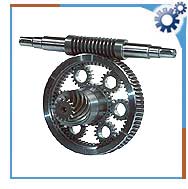 Cycloidal gears are used in pairs and are set at an angle of 180
degrees used to balance the load and are driven by multiple crank shafts
to share the load and increase torsion rigidity. The cycloidal gear
mesh with a large quantity of precisely ground steel pins. The combined
tooth contact area of the two cycloidal gears and pins ensures that the
load is distributed almost entirely around the pitch circle.
Cycloidal gears are used in pairs and are set at an angle of 180
degrees used to balance the load and are driven by multiple crank shafts
to share the load and increase torsion rigidity. The cycloidal gear
mesh with a large quantity of precisely ground steel pins. The combined
tooth contact area of the two cycloidal gears and pins ensures that the
load is distributed almost entirely around the pitch circle. With cycloidal gearing the input and output remains in constant mesh. Cycloidal gearing provides considerable latitude in selection of operating characteristics-deceleration, dwell periods, ratio of input to output motions etc. In cycloidal gear if the output crank is to stop then the drive pin must be on the pitch circle of the planet gear to avoid reversing of the motion.
Gearing Mechanism
Cycloidal gearing requires two different curves to obtain conjugate action. Two gears are placed on either side of a roller. The roller is rolled along the outer edge of one of the gear wheels. The curve traced out from this initial point of contact is called epicycloid. The same roller is then rolled on the inside edge of the other gear wheel generating another curve called hypocycloid. These two curves will be conjugate to each other. The smaller roller disk is called the generating circle for the gear set.
For cycloidal gear to be interchangeable, circles of the same size must generate them. The teeth of a cycloidal rack are cycloid generated by the rolling generating circle. They are not straight and their shape depends on the radius of the generating circle.